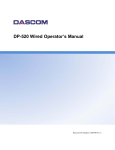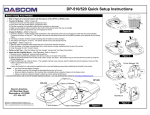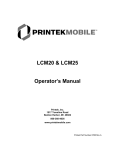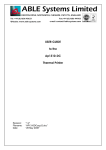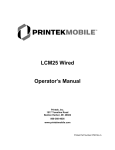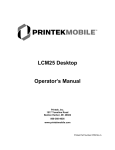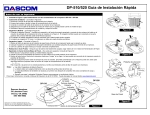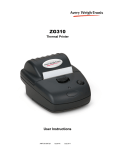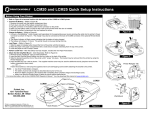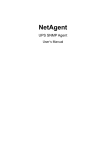Download Dascom DP-520 Operator`s manual
Transcript
DP-510 and DP-520 Operators Manual
Dascom Part Number 5206788 Rev A
Table Of Contents
Introduction ...................................................................................................................................................................1
Notes on Printer Firmware Revisions (Including Flash) .............................................................................................1
Copyright Notice And Disclaimer...............................................................................................................................1
Modes Of Operation ......................................................................................................................................................2
Idle Mode ....................................................................................................................................................................2
Sleep Mode..................................................................................................................................................................2
Spooling Mode ............................................................................................................................................................3
Battery Packs .................................................................................................................................................................4
Overview of Battery Operation ...................................................................................................................................4
Connecting the Battery Pack .......................................................................................................................................4
Charging the Battery ...................................................................................................................................................4
Battery Pack Handling Precautions .............................................................................................................................5
Battery Pack Capacity .................................................................................................................................................5
Paper..............................................................................................................................................................................6
Loading Paper .............................................................................................................................................................6
Paper Out and PAPER LID Sensors............................................................................................................................6
STATUS Indications .....................................................................................................................................................7
Printer Operation and Programming..............................................................................................................................8
Data Buffer..................................................................................................................................................................8
Spooling Mode ............................................................................................................................................................8
Character Printing and Fonts .......................................................................................................................................8
Graphics Printing and Other Programming Modes .....................................................................................................8
Interface Details.............................................................................................................................................................9
RS-232 Serial Interface (Applies to ALL MODELS) .................................................................................................9
IrDA Interface (Applies to DP-510 IrDA and DP-520 IrDA only) .............................................................................9
Bluetooth Interface (Applies to DP-510 Bluetooth and DP-520 Bluetooth only) .......................................................9
Connections and EMC Precautions .............................................................................................................................11
Connector Details ......................................................................................................................................................11
Connector Pinouts .....................................................................................................................................................11
Battery Charger Details .............................................................................................................................................11
Combined Data/Charger Adaptor Cable....................................................................................................................11
EMC Statement .........................................................................................................................................................12
EMC Caution.............................................................................................................................................................12
Wall and Belt Mounting Instructions...........................................................................................................................13
Getting Started.............................................................................................................................................................14
Connecting to a PC – A Checklist .............................................................................................................................14
Windows™ Printer Drivers .......................................................................................................................................14
Your Application Program ........................................................................................................................................15
Technical Support......................................................................................................................................................15
Dascom Americas
421 West Main Street
Waynesboro, VA 22980
877-434-1377
www.dascomamericas.com
INTRODUCTION
This document is an Operator’s Manual, written for the person connecting and using the Dascom DP-510 and DP520 thermal printers. Please read this document carefully before making any connection.
A separate Programmer’s Manual provides details of the control codes, and describes the internal operation of this
product.
NOTES ON PRINTER FIRMWARE REVISIONS (INCLUDING FLASH)
Dascom reserves the right to modify and improve the firmware in its printer products at any time. While every
effort is made to ensure backward compatibility, no guarantee in this respect is given or implied.
The DP-510 and DP-520 include a flash programmable microcontroller. This allows firmware upgrades under
customer control. Please contact Dascom Technical Support for more information.
COPYRIGHT NOTICE AND DISCLAIMER
Copyright © Dascom, Inc. 2010, 2011
Copyright © Able Systems Limited 2005
Dascom® is a registered trademark of Dascom Americas
Fujitsu® is a registered trademark of Fujitsu Limited.
Panasonic® is a registered trademark of Panasonic Corporation.
1
MODES OF OPERATION
The printer has three operating modes when not actually printing:
"Idle Mode": ready to accept data, but no data are in the buffer awaiting printing, and the printer is not
printing;
“Sleep Mode": effectively switched off;
"Spooling Mode": active, but storing data for later printing.
Modes are indicated by different color combinations on the front-panel Status Indicator. No light is emitted in sleep
mode.
There is no power switch, as power control is either automatic or by command from the host computer. To save
power, the printer enters sleep mode after a period of inactivity. It can also be programmed to stay idle indefinitely
or to go to sleep on command.
IDLE MODE
In idle mode, the printer is ready to receive data which will be printed as soon as complete lines or graphics patterns
are decoded. It responds to the paper feed button in the normal way, and can also produce a self test printout.
Power consumption is such that a fully-charged battery pack would last up to 10 hours, but the printer will normally
switch from idle mode into sleep mode when there is no activity, extending battery life.
SLEEP MODE
The printer enters sleep mode after a period of inactivity. This period is factory-set to 30 seconds (except Bluetooth
models which are factory-set to 4 minutes), but is programmable from the host.
In sleep mode, power consumption is negligible, but data stored in the buffer are lost. Special routines allow for
data to be printed out automatically before going to sleep. User programmable settings such as Baud Rate and
operational preferences are, however, retained during sleep mode or battery replacement. The system designer can
maximize battery life by arranging that the printer is generally in sleep mode, except when printing.
The printer enters sleep mode as follows:
by command from the host;
at the end of the (programmable) period of inactivity (This period is extended in spooling mode);
the battery voltage falls below a pre-set lower limit.
But, the printer will never enter sleep mode when:
a charger is connected;
data is being received;
the RS-232 "Wake-up" control line is 'active';
an IrDA connection is present (IrDA models only).
The printer is awakened from sleep mode as follows:
by pressing the paper feed button;
by connecting the external battery charger;
by an RS-232 data stream from the host: a certain period of logical '0' bits is required, typically a string of
50 NUL characters at 9,600 Baud. These data will be lost. There is a delay of up to 100 ms before the
serial output lines are established and the printer is ready to accept data;
by the RS-232 "Wake-up" control line becoming 'active';
by Infra-Red activity (IrDA models only).
2
SPOOLING MODE
In spooling mode, data are received and stored, but not printed. This is useful when printing needs to be suppressed
during data transfer (for example in mobile radio systems); or when the printer is unable to print because the paper
has run out or the lid is open.
The printer will automatically enter spooling mode when the paper is out, when the paper lid is open, if some other
error condition occurs, or alternatively by command from the host. Spooling mode may be cleared by host
command, automatically when the error condition is cleared, or by "double-clicking" the feed button. Power
consumption in spooling mode is similar to that in idle mode.
3
BATTERY PACKS
OVERVIEW OF BATTERY OPERATION
The printer is normally supplied with a standard 1.8Ah NiMH battery pack. The primary power for the printer
comes from the battery pack.
The printer can operate with or without a charger connected. If required, the charger can be operated continuously
to keep the battery fully charged, although a high printing duty cycle may reduce the charge in the battery.
Operation from the charger alone is not possible: a battery pack must always be installed.
Note: For safety the battery pack is shipped in the battery compartment, but discharged and disconnected.
Before use, the battery must be connected (see below) and then fully charged.
CONNECTING THE BATTERY PACK
The procedure for connecting the battery pack is as follows:
1. Remove the screw from the battery compartment door,
2. Push down, and slide back the battery compartment door,
3. Insert the battery pack connector taking care to insert it correctly,
4. Make sure the wires are correctly routed and not trapped.
CHARGING THE BATTERY
Plug the battery charger into a suitable power source and insert the plug into the power connector at the rear of the
printer. The Status Indicator will flash orange to show that the printer is charging.
There is also the option of charging the printer via the connector in the D9 data connector on the optional serial
cable.
4
BATTERY PACK HANDLING PRECAUTIONS
WARNING! Battery Handling Precautions
The battery pack contains an internal safety fuse, but the user must take care to avoid short-circuiting the
contacts by preventing them from touching any metallic object. For example, the battery pack should
never be carried loose in a pocket where it could rub against coins, keys or other metallic objects.
Short-circuiting the contacts of the battery pack will cause a heavy current to flow, which may lead to
excessive heating of the battery pack or any metallic objects connected to it. This could cause burns, or
start a fire.
WARNING! Do Not Try To Open The Battery Pack
The standard battery pack contains five Nickel-Metal-Hydride Cells. Exposing the cells increases the
risk of leakage or short-circuiting.
CAUTION: It is strongly recommended that the external charger is disconnected whenever the battery pack
is removed or replaced.
Please observe local standards for the handling, transport and disposal of Nickel-Metal-Hydride Cells.
BATTERY PACK CAPACITY
The printer is supplied with a 1.8Ah NiMH battery pack. This battery pack should be recharged while installed in
the printer which takes about 15 hours. The capacity of the battery pack when fully charged will normally be
sufficient to print normal text on about four full rolls of paper. However, the amount of printing which can be
achieved depends greatly on the printing density, idle time and other factors such as the ambient temperature and the
history of the battery pack.
With the printer awake but idle, a fully charged battery would last for up to 10 hours, but the built-in sleep mode
shuts down the printer completely, reducing energy consumption to a negligible rate.
In the event of the battery becoming exhausted, the printer will automatically protect its own control circuitry by
entering sleep mode if the instantaneous battery voltage drops below a threshold (e.g. during a particularly heavy
section of print). In this case data stored in the buffer are lost.
The battery pack should be capable of up to 500 complete charge and discharge cycles, though this may be reduced
in very repetitive applications. If a particular battery pack appears not to be holding charge as well as expected, it
may be worn out and should be replaced.
During battery charging the printer may become quite warm. This can crease the paper within the mechanism. You
may wish to feed out some paper before printing begins, either controlled from the host, or by the user pressing the
paper feed button.
5
PAPER
Pressing the paper feed button when the printer is idle advances paper at typically two inches per second, depending
on the battery voltage. However, the paper feed button has several additional functions:
A single press and release of the button:
in idle or spooling mode, advances paper;
in sleep mode, wakes up the printer into idle mode;
"Double-clicking" the button: (i.e. pressing and releasing twice in quick succession just like a PC mouse)
in idle mode, prints a self test message including the firmware version, encoded calibration data, and the
full character set;
in spooling mode, or having been out of paper, prints any stored data and enters idle mode.
Some of the functions of the paper feed button can be invoked or disabled under control of the host.
LOADING PAPER
The procedure for loading paper is as follows:
1.
2.
3.
Slide the Lid Release Button forwards until the Lid springs open.
Unwind a small amount of paper from the roll and Insert the Paper Roll into the Printer.
Close the Lid down, and the paper is loaded.
After loading, check that the paper advances properly, and tear off any excess by pulling the paper sharply towards
you across the serrated tear bar. In the event of a jam or other paper loading problem, release the lid and straighten
the paper before closing again.
PAPER OUT AND PAPER LID SENSORS
A reflective optical Paper Out sensor within the mechanism detects an out-of-paper condition, and/or senses black
marks to register with pre-printed forms. A mechanical sensor detects when the paper lid is open.
By default, the printer enters Spooling mode automatically if either sensor becomes active. Spooling mode is
automatically exited, and any stored data printed, when new paper is loaded and the lid closed. This behavior may
be modified. Please refer to the Programmers’ Manual for details of how to configure these functions.
6
STATUS INDICATIONS
The Status Indicator at the front of the printer has a number of color combinations, which repeat in up to a 4-phase
pattern to provide status information (see table below).
In summary, if the indicator is constant green it indicates that the printer is operating normally from its battery pack.
Flashing on and off indicates that Spooling mode is active and no printing can take place. Orange advises the
battery is being charged. Red warns of a low battery or other problem.
No light indicates that the unit is in sleep mode, has a discharged battery, or the battery is not connected.
Status Indicator Pattern Table
Pattern
Battery
Constant Green
Running
Fast Flashing Green
Running
Long Green - Short Red
Battery Low
Short Green - Short Red
Battery Low
Short Green - Long Orange
Trickle Charging
Long Orange Flashing
Trickle Charging
Fast Flashing Red
Error Condition
No light
Discharged, or in sleep mode
* (Spooling Mode may have resulted from Paper Out or Paper Door Open conditions)
Buffer Mode
Normal
Spooling *
Normal
Spooling *
Normal
Spooling *
Spooling (Printing prohibited)
Although this table may seem complicated, few applications will produce many of the combinations.
Other Status Indicator Patterns
Other patterns may be programmed into the printer by the system designer.
Please refer to the Programmer’s Manual for details of how to configure these functions.
7
PRINTER OPERATION AND PROGRAMMING
The DP-510 and DP-520 printers utilize a Fujitsu FTP-628MCL103 printer mechanism, with a fixed (parallel) print
head with 384 horizontally-arranged thermal elements. The paper is advanced by a stepper motor, and printing takes
place in a single dot row for each step of the paper. Each printed dot is approximately 0.005” square. The printing
speed and dot density are controlled according to the battery voltage and the head temperature.
Various printing modes, including graphics, are invoked by 'Escape' sequences. Control codes and status report
protocols are described in detail in the Programmer’s Manual.
DATA BUFFER
The printer has a nominal 20k byte buffer to optimize throughput: this enables data to be received into the buffer
while previous lines are being printed. Printing will be initiated on receipt of a valid logical line of data or a
complete graphics pattern.
The buffer may be cleared by data command or by a hardware reset. A partially full line will be printed on receipt
of an appropriate control code, or after a programmable timeout delay.
SPOOLING MODE
Spooling mode can be entered by:
a command from the host;
Paper Out condition or Paper Lid open condition being sensed;
an error condition (e.g. head over temperature, battery over voltage, etc).
In spooling mode, the buffered data are stored without being printed until the mode is exited by:
a command from the host;
the 'causing condition' (e.g. Paper Out or Paper Lid open) being cleared;
the paper feed button being double-clicked.
CHARACTER PRINTING AND FONTS
The default 32-column character set is formed from a 24x10 dot matrix, and is based on the industry standard IBM®
character set Code Page 437. This character set has been modified to include the Euro symbol (‘€’) at position 80H
(128 Decimal), in place of the usual capital C with cedilla (‘Ç’).
Various combinations of single or double width, single or double height, inverted, underlined, and other attributes
may be mixed within a line.
Customized fonts may be created using a font editor utility, and downloaded to the printer. Only a single custom
font may be loaded in the printer at one time. Contact Dascom Technical Support for more information on the font
editor utility.
GRAPHICS PRINTING AND OTHER PROGRAMMING MODES
Various dot-addressable graphics modes are supported, at up to 384 dots per line. The Windows driver operates in
the graphics mode. Refer to the Programmer’s Manual for full details of this and other advanced programming
modes.
8
INTERFACE DETAILS
RS-232 SERIAL INTERFACE (APPLIES TO ALL MODELS)
All DP-510 and DP-520 printers have an industry standard RS-232 interface. The default parameters are 9600 baud,
8 data bits, 1 stop bit and no parity. Other baud rates can be programmed by control codes, or by using a setup
utility. Contact Dascom Technical Support for information regarding the setup utility.
Serial data is expected in standard RS-232C format with -12V meaning 'mark' or '1' and +12V a logical '0', with
reference to the common ground. The serial data output line, TxD, transmits XON/XOFF and status information to
the host at the same Baud rate and in the same format as the serial data input. The hardware busy line is true
(nominal -12V) when busy. Both serial output lines will relax to approximately 0V when the printer is in sleep
mode, and the user must allow a short period after awakening before relying on the values of these signals.
Some host equipment use a constant space condition (+12V) to indicate a reset condition or wait state. Some battery
powered host equipment present the same output signal when they go to sleep. The printer can be set to ignore this
condition as detailed in the Programmer’s Manual, but even then this type of host behavior may result in one or
more spurious characters being received and printed, or the printer may be prevented from going to sleep.
IrDA INTERFACE (APPLIES TO DP-510 IRDA AND DP-520 IRDA ONLY)
IrDA models feature an Infra-Red window on the front of the body. It includes special hardware which wakes the
printer when any Infra-Red activity is detected. In order to reduce the occurrence of 'false triggers', the sensitivity of
this wake-up sensor is reduced. It may be necessary to bring the host IrDA device fairly close to the printer before it
will wake up.
Once awake, the printer will respond to communications from an IrDA compliant primary device. The printer
supports 'point-to-point' applications (i.e. one primary device and one secondary device). It operates only as a
secondary device, and cannot initiate a link between devices.
Once a link is established then the printer shows a red indicator through the IR window on the front. The link will
continue as long as the devices are maintained in line-of-sight and within operating range. While a link is
maintained, data may be exchanged freely between the two devices.
The protocols supported are as follows: IrPHY V1.0, IrLAP, IrLMP, IAS, TinyTP and IrCOMM 9-wire.
BLUETOOTH INTERFACE (APPLIES TO DP-510 BLUETOOTH AND DP-520 BLUETOOTH ONLY)
Bluetooth models include a class 2 implementation of the Panasonic PAN1440 module, which is Bluetooth 1.1
compliant, and is certified to EN 300 328. The protocols and profiles supported are as follows: LM, L2CAP,
RFCOMM, SDP, TCS, SPP (Serial Port Profile).
The detail of how to establish a Bluetooth link and transfer data will vary greatly depending on the primary host
device. However, the process will generally involve the following stages:
i.
ii.
iii.
iv.
v.
Discovery of Bluetooth devices;
Discovery of the printer’s services;
Selection of the Serial Port Profile;
It may be necessary to Pair with the printer;
Connecting to the printer.
Note. The PIN for making a secure connection to the printer is pre-set to “1234”.
Usually the Bluetooth link is maintained for as long as the devices are within operating range. While the link is
active, data may be exchanged freely between the two devices. Occasionally the link may be lost, in which case the
user should re-initiate the link from the primary host as described above.
9
There is no facility to wake the printer over the Bluetooth link. The printer must be awake before a Bluetooth link
may be established and any data can be transferred to it via the Bluetooth interface. Because of this, the default
Sleep Period for the Bluetooth models is extended to 4 minutes.
10
CONNECTIONS AND EMC PRECAUTIONS
CONNECTOR DETAILS
The printer has two user connectors shown below:
Pin 1
Charger Input
RJ12 Combined Data Socket
CONNECTOR PINOUTS
Charger Input Socket Detail
Pin
Inner
Outer
Dimension (mm)
Inside Ø 2.5
Outside Ø 5.5
Function
Positive / Charger Input
Negative / 0V Common
The maximum insertion length is 12 mm.
RJ12 Combined Data Socket Detail
Pin
1
2
3
4
5
6
Signal Direction
To Printer
To Printer
To Printer
To Host
To Host
---
Description
Optional Charger Input
Wake-up Input
RS-232 Rx data
RS-232 Tx data
RS-232 Busy
0V Common (RS-232 signal return and Charger return)
BATTERY CHARGER DETAILS
The printer monitors charge current into the printer, but does not regulate it in anyway. In order to fully and safely
charge the batteries, use only Dascom Battery Charger Adapters.
Caution: This connection is for a current-regulated battery charger only. Do not connect a standard voltage
power supply. Serious damage may result from inappropriate connections.
COMBINED DATA/CHARGER ADAPTOR CABLE
An optional serial data cable suitable for connecting the printer to a standard PC is available. This cable features an
integrated charger connector in the housing of the DB-9 connector. For trickle charging, the charger may optionally
be connected directly into the printer’s connector, or indirectly into the connector in the data cable, thus giving the
maximum system wiring flexibility.
The connections to a standard PC COM port are as follows:
11
DB-9 Pin
3
2
4
6&8
5
Name
TxD
RxD
DTR
CTS & DSR
SGND
Description (refers to PC)
Serial Data Output
Serial Data Input
Handshaking Output
Busy Input
Signal Common 0V
RJ12 Pin
3
4
2
5
6
The wake-up input (pin 2 of the RJ12) can be driven by a normal RS-232 handshaking output and activates the
printer when a positive voltage ('space' condition) is asserted. Connecting it to the PC DTR signal wakes the printer
when the COM port is 'opened'. It may alternatively be tied to a positive voltage in the range +3V -> +12V to keep
the printer awake permanently. In this case, the printer will 'attempt' to go to sleep if the normal inactivity time-out
elapses, but will merely reset and then re-start. This behavior may be avoided by switching off the sleep period
timeout.
EMC STATEMENT
The DP-510 and DP-520 printers are fully EMC (Electro-Magnetic Compatibility) compliant and are CE marked
accordingly. A Declaration of Conformity, in accordance with the EMC Directive 89/336/EEC (and as amended) is
available on request.
EMC Caution
System EMC compliance remains the responsibility of the system designer. It is recommended that shielded cables
are used; grounding arrangements will depend on the application.
12
WALL AND BELT MOUNTING INSTRUCTIONS
A combined bracket/clip suitable for attaching the printer to a wall or belt is available
The bracket snaps into the bottom of the printer, and when used to clip to a belt, it may be secured by using the
supplied extended screw (replaces the battery compartment screw). Prior to use, two small 'break-outs' must be
removed from the battery cover of the printer as shown below:
Remove the two 'break-outs'
using a small screwdriver.
When attaching to a belt, the bracket should be put on the printer first, and then the entire assembly clipped over the
belt as shown:
The securing screw may be used if required.
When attaching to a wall, the bracket must be located on the wall using screws and wall plugs as shown. The printer
may then be clipped into place and removed as required.
Use a finger or small screwdriver to
release the clip and then gently lift the
printer to remove from the wall bracket.
13
Getting Started
You may find that you can connect the printer to your Personal Computer (PC), and everything works perfectly the
first time. However, there are many variables, and the following guide may help if you find you need some
assistance. These are only suggestions, and may not work with all PC’s.
Connecting to a PC – A Checklist
First, MAKE SURE THE PRINTER IS OPERATIONAL
Make sure that the battery pack is connected. Remember that operation from the charger alone is not possible: a
battery pack must always be installed. Also remember that battery packs are normally supplied disconnected
and discharged. They should be connected and then fully charged before use (e.g. trickle charged for at least
15 hours).
Wake the printer up by pressing the Paper Feed button once and releasing it. The Status Indicator should light; if it
does not, the battery may be discharged (or not connected correctly): connect the charger, and the status indicator
will come on.
When the printer is awake, load paper and then press the feed button to check that paper feeds. Press the paper feed
button again twice in quick succession (like double-clicking a PC mouse) and the printer should print a self-test
message. This will show that the printer is operational, and also reports how the printer’s serial data interface is
configured.
Next, CONNECT THE PRINTER TO THE PC
The back panel of a PC typically includes several D-type (keystone-shaped) connectors. One of these is usually:
DB-9 Plug (male):
COM1: Serial port for mouse, modem, serial printer, etc
You can use any available serial port for the printer. COM1: is assumed in what follows, as most likely to be
available.
You will need a suitable cable. Use either a standard cable from Dascom (see Section ‘Combined Data/Charger
Adaptor Cable‘), or make up your own using the information in the same section.
Now you will need to SET UP YOUR COMPUTER’S SERIAL PORT to match the printer (it is also
possible to change the printer’s settings, but not until you have established communication with the computer).
Your proposed application program may have a way of doing this, or you can get to the DOS prompt [e.g. C:\>] and
type the following command line (assuming you have connected the printer to COM1:):
MODE COM1:9600,N,8,2 [RETURN]
This will set up the port (COM1:) to 9600 baud, No parity, 8 data bits, and 2 stop bits which is the default setting for
the printer.
Now, SEND SOME DATA TO THE PRINTER from your computer. An easy way to do this from the DOS
prompt is to type:
DIR >COM1: [RETURN]
This should send a directory listing to the printer. The lines will probably overflow, but it will at least show that the
communication between the computer and the printer is working.
Alternatively, in Windows, use the TERMINAL program to send some text to the printer.
Windows™ Printer Drivers
14
A Windows driver specifically written for the printer is available and can be downloaded from www.Dascom.com.
It may be necessary to adjust some settings in your Application to produce the desired result.
It is important to recognize that other Windows printer drivers, even for ESCPOS compatible printers, may not work
with the DP-510 or DP-520, as they format everything as dot graphics patterns, in a way which is unique to each
kind of printer. The Windows “Generic Text Only” printer driver should, however, work in a limited manner.
Various applications and Tool Kits which fully support the DP-510 and DP-520 are available for PDA’s and other
Pocket PC platforms from www.fieldsoftware.com. When using these tools, select the Able Systems
AP1300/AP1310.
Your Application Program
Once communications between your computer and the printer have been established, you can try driving the printer
from your application program. As referred to in the Programmer’s Manual, the printer has a control code set based
on the EPSON ESCPOS protocol. Many of the commands are as closely compatible as they can be, given the
mechanical differences between printers, but if the application program was originally written for another printer, it
may need to be modified.
Technical Support
You may contact Dascom Technical Support for assistance at 877-434-1377.
15



















